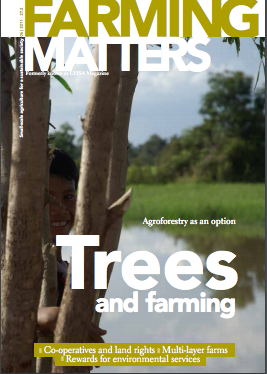Trees bring many benefits, even if these are not immediately visible and not all farmers recognise it. Here are some examples from different parts of the world about how trees help increase production and incomes.
Nepal: Ensuring water availability
The lowlands ranging from the Chure hills to the border with India, or the Terai, have for long been known as Nepal’s “food bowl” region. The grazing fields and the forests at the feet of the Chure hills, known as Char Koshe Jhadi, helped filter the sand and debris in the waters flowing downhill, while ensuring the availability of water (and nutrients) to the farm lands downstream. But large parts of the forest area have been cut down and floods have become more common. At the same time, farmers are experiencing problems with the groundwater irrigation systems, as the water tables have lowered drastically.
Fortunately, there is a growing recognition in public and private organisations of the advantages of having a forest close to farms and of agroforestry in general. The government of Nepal is supporting the Chure Watershed Conservation Programme, through which farmers are planting fast-growing multipurpose tree species along field boundaries, on bunds and on marginal lands. This is providing new employment opportunities to local communities and farmers are already experiencing higher yields.
More information?
Contact Pramila Dhakal, currently studying at the College of Agriculture and Natural Resources, National Chung Hsing University, Taichung, Taiwan.
E-mail: forpramila@gmail.com
Cameroon: A broader income case
Based in the south-west region of Cameroon, CENDEP runs training programmes in the domestication, sustainable production and marketing of non-timber forest products. Its Analogue Forestry programme helps farmers to increase yields and the diversity of their production by introducing native and exotic tree species that have an economic and ecological value.
The focus is mainly on restoring and protecting deforested areas that serve as communal watersheds. In addition to running a training programme, CENDEP has convinced local authorities to assign previously uncultivated communal land to women’s groups. The forests they establish and protect are designed to work as “carbon sinks”, and they hope to benefit from the REDD+ funding mechanisms. CENDEP is currently addressing the issues involved in making such an application (such as measuring carbon quantities, and securing the land rights of indigenous communities). In contrast to other initiatives, their efforts are not directed at “not harming the forests”, but rather focus on “positive actions”: preparing management plans and sustainably harvesting products.
More information?
Contact Wirsiy Eric Fondzenyuy, Knowledge Management Officer, CENDEP Cameroon. P.O. Box 742 , Limbe, SW Region, Cameroon.
E-mail: wirsiyef@yahoo.com
Honduras: Alternatives to slash and burn
Shifting cultivation has been practiced with relative success for thousands of years. But growing populations mean that farmers are often forced to use shorter fallow periods. The land becomes incapable of restoring itself, degrades, and becomes unproductive. One alternative, tried successfully in different countries, is to plant rows of Inga edulis, which can be pruned after two years, and then sowing maize in the mulch of leaves and thin branches. Not only are better harvests achieved, but, as the nutrients are recycled through the mulch, the fertility of the soil is maintained, making it possible to farm in one place for many, many years. The main benefit is that far less forests will be destroyed by slash and burn agriculture.
FunaVid, a local environmental charity, together with Rainforest Saver, a U.K. charity, is setting up a demonstration farm in the Atlantida department, not far from the Pico Bonito National Park. Working closely with the CURLA University in La Ceiba, their objective is to convince farmers and students of the benefits of combining trees and farming for sustainable yields and incomes.
More information?
Visit the Rainforest Saver website (www.rainforestsaver.org) or contact Charles Barber: charles.barber13@gmail.com
The Netherlands: Maintaining cultural heritage
Farmers in the Netherlands have been keeping cattle and producing milk since the Middle Ages. Their grasslands included trees like alders (Alnus glutinosa) or willows (Salix spp), which were important sources of firewood and timber. Since the 1950s, however, the demand for firewood decreased dramatically (as farmers came to rely more on fossil fuels to heat their homes), and many farmers saw no reason to keep trees on their farms – especially because they made mechanisation more difficult. Yet, it is now increasingly recognised that this agroforestry landscape is part of a cultural heritage, which must not be lost.
Plans are being discussed for a national “landscape fund” to support farmers. In the meantime, local authorities in the area known as the Gelderse Vallei are taking steps in the same direction. By combining subsidies with income-generating activities, farmers are able to benefit from the growing demand among the urban population for green areas or for “traditionally produced” products. Some farmers are even starting to grow alders as a local source of firewood for heating their stables, thus reducing their energy costs.
More information?
Write to Hans Peter Reinders at the municipality of Leusden, where he works as policy advisor.
E-mail: hpreinders@hotmail.com

